Das Truppenführungssystem „ALMAS“ der DDR
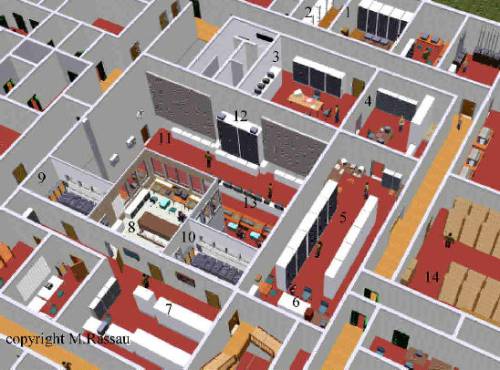
1 Sende- und Empfangsapparatur
2 Fernschreiberdokumentation
3 Rechnerraum
4 Dokumentationsapparatur
5 Hauptspeicher
6 Zentrales Systemkontrollpult
7 Darstellungsapparatur
8 Kontrollpult der Projektoren
9 Projektoren der Gefechtsführung
10 Projektoren des Aufklärungszentrums
11 Luftlagedarstellung der Gefechtsführung
12 Großsichtanzeigetafel
13 Arbeitsplätze des Aufklärungszentrums
14 interne ALMAS-Nachrichtenapparatur
Dank ausgereifter sowjetischer Technik und einem ausgeklügelten Eigentestsystem konnte ein Koeffizient der technischen Einsatzbereitschaft von besser als 98 % im Jahr gehalten werden.
Alle Wände sind auch hier zum EMP-Schutz mit verschweißten 6 mm-Stahlblechplatten ausgekleidet.
Nicht zu sehen ist die auch immer einsatzbereite DDR-Kaffeemaschine hinter dem Kontrollpult.
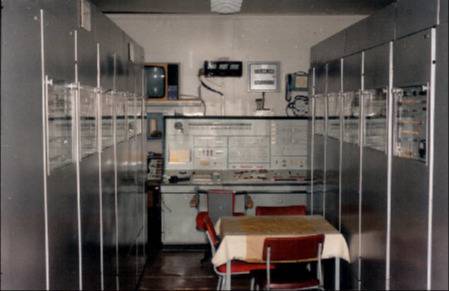
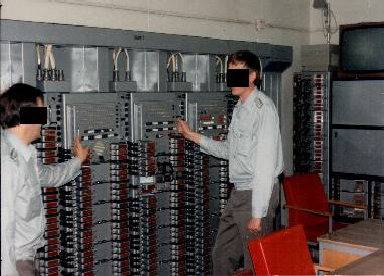
Mit dem „ALMAS“-System waren alle Mitgliedstaaten des Warschauer Vertrages in einem einheitlichen Datennetz der Luftlage verbunden.
Die Offiziere der 1. Stammbesatzung erhielten ihre spezielle Ausbildung 1977 an der sowjetischen Militärakademie in Kalinin / Twer.
Links einer der beiden Rechner des sowjetischen automatisierten Führungssystems, ausgestattet mit einer Mikroprogrammsteuerung und netzausfallsicheren Ferritkernspeichern.
Die Kodierungen des Flugmeldenetzes wurden periodisch noch per Hand mit dünnen Drähten eingefädelt.
Der zweite Rechner lief immer als "heiße" Reserve mit und erhielt alle 10 Sekunden die aktuellen Daten vom Hauptrechner.
Das Geräusch der Rechner im Rauschpegel der Lüftung:
Im Dokumentationsraum befanden sich zwei Tonbandmaschinen zur ununterbrochenen Aufzeichnung aller ein- und ausgehenden Fernschreibinformationstelegramme des Systems „ALMAS“.
Wie in den anderen Bereichen des „Fuchsbau“ waren auch hier weibliche Berufssoldaten integriert.
Der Druckerarbeitsplatz zur Dokumentation der vom Rechner bearbeiteten Meldedaten und der Terminaleingaben von den 26 Arbeitsplätzen des operativen Personals.
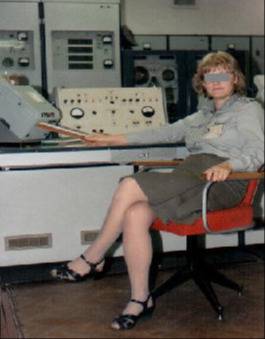
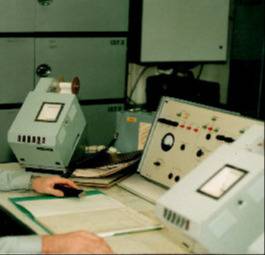
Das typische Druckergeräusch.
Bemerkung: Diese Fotos wurden am letzten Tag der NVA gemacht. Zuvor wäre es undenkbar gewesen!
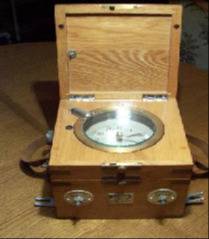
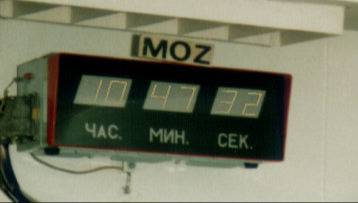
Davon waren 30 in den Diensträumen des Bauwerkes installiert.
Im Originalzustand dienten zwei wunderschöne Chronometer aus Messing mit Holzgehäuse und Thermostat als Systemtaktgeber.
Alle 48 Stunden wurden diese vom Operateur per Hand aufgezogen.
Die Chronometer wurden bald durch eine analoge Quarzuhr aus DDR-Produktion ersetzt.
Einem General war aufgefallen, dass die sowjetischen "ALMAS"-Uhren immer 10 Sekunden am Tag nachgingen...
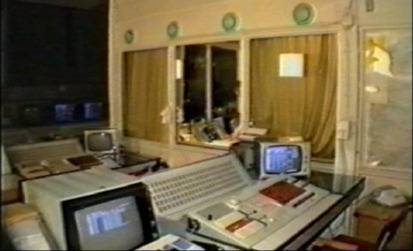
Einer der 26 Arbeitsplätze des Systems „ALMAS“ im Führungsraum von 1990.
Am schrägen Kopfteil sind die 5 Zeilen zur digitalen Anzeige von Zieldaten zu erkennen.
Auf der linken Pulthälfte ist die Wechselsprechanlage eingelassen.
Die rechte Hälfte nimmt die Tastatur zum Aufrufen der Zieldaten und Eingabe von operativen Steuerkommandos auf.
Die aufgestellten Videomonitore sind keine Bestandteile des „ALMAS“-Systems.
Der Hauptspeicher des Führungssystems mit seinen 8192 Worten je 26 Bit auf Ferritkernbasis in seinem temperaturgeregelten verschlossenen Block.
Die Steckkarten des Systems waren äußerst servicefreundlich gebaut und aus Dioden-Transistor-Logikmodulen zu funktionellen und universellen Einheiten zusammengesetzt.
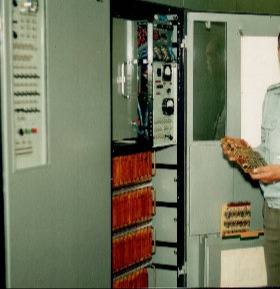
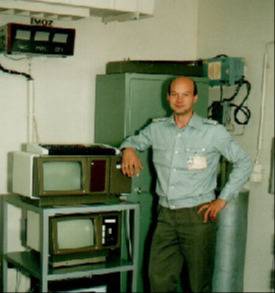
Der Autor dieser Seiten im "ALMAS"-Rechnerraum neben dem im ZGS-14 auf der Basis von DDR-Bürocomputern entwickelten Mini-Führungssystem "MIDA-32", das ab 1985 bei einfachen Luftlagen, nachts und am Wochenende, zum Einsatz kam und kompatibel mit dem sowjetischen System war. "ALMAS" brauchte 350 m² Fläche, 120 kW Elektroenergie und 15.000 m³ Luft pro Stunde zum Kühlen.
Der Bildschirm des Gefechtsführungsraumes mit dem täglich durchgeführten Abgleichtest der Projektoren.
Daneben auf der linken Hälfte des Großtableaus wurden z.B. die gefechtsbereiten Flugzeuge und Raketen für den Chef und seine Stellvertreter angezeigt.
Bei Gefechtshandlungen erschienen hier die durchgeführten Starts und Abschüsse, sowie auch die Anzahl der Kernwaffenschläge auf dem Gefechtsfeld.
Auf der rechten Seite des Tableaus kamen die aktuelle Anzahl der von den Divisionen und Nachbarstaaten erhaltenen bzw. gesendeten Ziele, Zustände der Nachrichtenkanäle sowie weitere statistische Systemdaten speziell für die Offiziere des Aufklärungs- und Informationszentrums (AIZ) zur Anzeige. Im Vorraum zum AIZ befand sich das System "ALMAS-3" zur manuellen Dateneingabe.
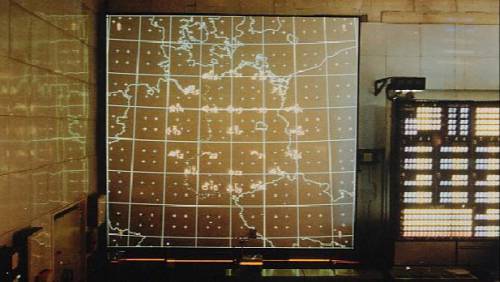
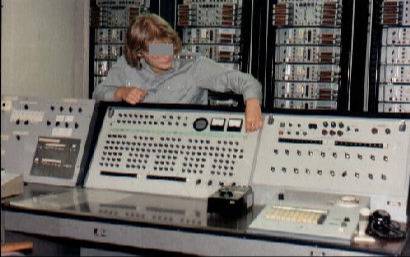
Der Raum mit der automatischen Datenfernübertragungseinrichtung für die Informationstelegramme des Führungssystems.
Diese wurden in Fernschreibkodierung übertragen und im benachbarten Spezialnachrichten-Raum noch verschlüsselt.
Vom Bedienerpult konnten auch Simulationen und aufgezeichnete Situationen vom Magnetband eingespielt werden.
Im Nachbarraum waren neben der Rohrpostanlage die Fernschreibmaschinen installiert, die bei den zwei täglichen Funktionskontrollen im gesamten „Ostblock“-Bereich und bei Alarmen zur Dokumentation zugeschaltet wurden.
Aus Tarnungsgründen wurde vom ZGS-14 aus nur von abgesetzten Standorten gesendet.
Die Datenübertragung erfolgte deshalb hauptsächlich über gedeckte Drahtkanäle.
In der Kanzel der Zwischenetage arbeitete auch die Richtungsgruppe, der Gefechtsabschnitt IV.
Bei Führung über Funk wurde automatisch der Überflug von Aufklärungssatelliten signalisiert.
Im Vordergrund das Kontrollpult für die Projektoren zur Darstellung der statischen und dynamischen Luftlageinformationen auf den beiden Großbildschirmen des Führungssaals.
Die Zielzeichen wurden im Projektor automatisch auf eine mit Aluminium beschichtete Folie von 10x10 cm "gebrannt" und auf ein Format von 4x4 m vergrößert, zweifarbig dargestellt.
Den Darstellungsmodus steuerte die operative Besatzung je nach Bedarf selbst.
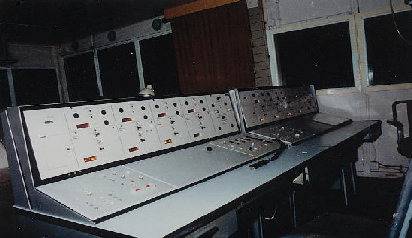
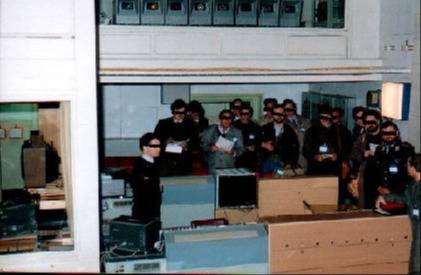
Im Vordergrund der Arbeitsplatz von Generaloberst Reinhold, des Chefs der Luftstreitkräfte/Luftverteidigung der DDR bis 1989.
Am linken Bildrand ist der durch Fenster abgeteilte Raum des „Diensthabenden FBZ“ zu sehen.
Kurzbeschreibung "ALMAS-2"
"ALMAS-2" war ein militärischer Komplex zur automatisierten Leitung eines Luftverteidigungskrieges mit Jagdflugzeugen und Flugabwehrraketen ausschließlich über dem Territorium der DDR.
Hergestellt wurde es in den 1970er Jahren in der Sowjetunion und war in allen Staaten des Warschauer Vertrages vorhanden. Es war ein stationäres System ohne Bewaffnung.
"ALMAS-2" ist ein Kodename und bedeutet übersetzt nur "Diamant".
"ALMAS-3" war ein kleines Teilsystem, das in den unterstellten Divisionen installiert war.
"ALMAS-1" dagegen war der Hauptkomplex in der vorgesetzten Führungsstelle der Warschauer Vertragsstaaten bei Moskau.
Im Frieden wurde "ALMAS-2" der DDR täglich zur Überwachung des Luftraumes und Verwaltung der verfügbaren Luftabwehrmittel an der Grenze zur NATO benutzt.
Die Informationen für den Computer von "ALMAS-2" lieferten hauptsächlich die beiden Luftverteidigungsverbände im Nord- und Südraum der DDR.
Von den Computern aufbereitet wurden die Daten in Form von Grafiksymbolen automatisch auf zwei Leinwandtafel projeziert. Eine Mannschaft aus Offizieren analysierte die gemeldeten Anflüge.
Dazu standen ihnen bis zu 26 automatisierte Arbeitsplätze im Bunkersaal zur Verfügung.
Zwei Großsichtanzeigetafeln informierten sie über anfliegende gegnerische Flugzeuge und die eigenen Waffenbestände.
Die Offiziere konnten auf Grundlage der angezeigten eigenen Abwehrmittel per Computerprogramme die Gefährdung der DDR beurteilen. Bei Bedarf wurde dem Befehlshaber ein vom Computer berechneter Entschluß zum Waffeneinsatz vorgeschlagen. Danach konnte er den Einsatz von Abfangjägern und Flugabwehrraketen für die unterstellten Divisionen befehlen.
An den Komplex "ALMAS-2" der DDR waren auch die Nachbarstaaten Polen, Tschechoslowakei und die Sowjetunion informell angekoppelt. Was früher nur per Telefonen und Funkgeräten an Meldungen ausgetauscht wurde, geschah mit "ALMAS-2" nun automatisch mit Hilfe des Computers.
Die Bedienmannschaft steuerte den Informationsaustausch von ihren automatisierten Plätzen aus.
Durch diese automatisierte Führungsvariante war es erstmalig möglich geworden, dass alle Teilnehmerstaaten des Warschauer Vertrages über eine aktuelle einheitliche Luft- und Gefechtslageübersicht verfügen konnten.

